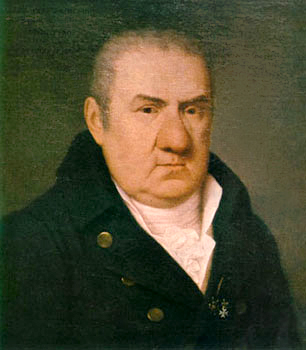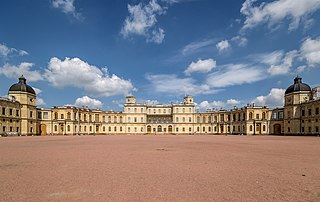

The Chinese Village in the Alexander Park of Tsarskoye Selo, Russia was Catherine the Great's attempt to follow the 18th-century fashion for the Chinoiserie. [1]


The Chinese Village in the Alexander Park of Tsarskoye Selo, Russia was Catherine the Great's attempt to follow the 18th-century fashion for the Chinoiserie. [1]
Probably inspired by a similar project in Drottningholm, Catherine ordered Antonio Rinaldi and Charles Cameron to model the village after a contemporary Chinese engraving from her personal collection. The village was to consist of 18 stylized Chinese houses (only ten were completed), dominated by an octagonal domed observatory (never completed at all). After Catherine failed in her ambition to procure a genuine Chinese architect, the Russian ambassador in London was instructed to obtain a replica of William Chambers's Great Pagoda in the Royal Botanic Gardens, Kew for Tsarskoye Selo, a central structure of the Chinoiserie architecture.
Catherine's death in 1796 led to the works being suspended. It was not until 1818 that tsar Alexander I of Russia asked the famous architect Vasily Stasov to overhaul the village in order to provide accommodation for his guests. Although much of the original orientalizing decor was lost as a result, the renovated village provided habitation for such eminent visitors as Nikolai Karamzin who worked on his History of the Russian State in one of the houses between 1822 and 1825.
The Chinese Opera Theatre was constructed not far from the village in 1779. It was there that an Italian composer Giovanni Paisiello would present his new operas to the Russian empress. The première of Leo Tolstoy's The Fruits of Enlightenment was also produced there. The theatre was burnt to the ground on 15 September 1941 and has never been rebuilt.
Three remarkable bridges lead to the village. The Dragon Bridge, so named after four zinc figures of winged dragons, and the Large Chinese Bridge, noted for pink granite vases and imitation coral branches, were completed in 1785. The Cross-Shaped Bridge had been constructed by the Neyelov Brothers six years earlier (illustrated, to the right).
The village was renovated under the direction of Ippolit Monighetti in 1859-61. The cottages sustained serious damage during the Nazi occupation but were restored in the 1990s to provide lodgings for VIP guests.
![]() Media related to Chinese Village in Tsarskoe Selo at Wikimedia Commons
Media related to Chinese Village in Tsarskoe Selo at Wikimedia Commons

Pushkin is a municipal town in Pushkinsky District of the federal city of St. Petersburg, Russia, located 24 kilometers (15 mi) south from the center of St. Petersburg proper, and its railway station, Tsarskoye Selo, is directly connected by railway to the Vitebsky Rail Terminal of the city.

Tsarskoye Selo was the town containing a former residence of the Russian imperial family and visiting nobility, located 24 kilometers (15 mi) south from the center of Saint Petersburg. The residence now forms part of the town of Pushkin. Tsarskoye Selo forms one of the World Heritage Site Saint Petersburg and Related Groups of Monuments.

The Catherine Palace is a Rococo palace in Tsarskoye Selo (Pushkin), located 30 kilometres (19 mi) south of St. Petersburg, Russia. It was the summer residence of the Russian tsars. The palace is part of the World Heritage Site Saint Petersburg and Related Groups of Monuments.

Chinoiserie is the European interpretation and imitation of Chinese and other Sinosphere artistic traditions, especially in the decorative arts, garden design, architecture, literature, theatre, and music. The aesthetic of chinoiserie has been expressed in different ways depending on the region. It is related to the broader current of Orientalism, which studied Far East cultures from a historical, philological, anthropological, philosophical, and religious point of view. First appearing in the 17th century, this trend was popularized in the 18th century due to the rise in trade with China and the rest of East Asia.

The Alexander Palace is a former imperial residence near the town of Tsarskoye Selo in Russia, on a plateau about 30 miles (48 km) south of Saint Petersburg. The Palace was commissioned by Catherine the Great in 1792.

The Imperial Lyceum in Tsarskoye Selo near Saint Petersburg, also known historically as the Imperial Alexander Lyceum after its founder Tsar Alexander I, was an educational institution which was founded in 1811 with the object of educating youths of the best families who would afterwards occupy important posts in the Imperial service.

Charles Cameron was a Scottish architect who made an illustrious career at the court of Catherine II of Russia. Cameron, a practitioner of early neoclassical architecture, was the chief architect of Tsarskoye Selo and Pavlovsk palaces and the adjacent new town of Sophia from his arrival in Russia in 1779 to Catherine's death in 1796. Cameron concentrated exclusively on country palaces and landscape gardens. Twice dismissed by Paul of Russia during the Battle of the Palaces, Cameron enjoyed a brief revival of his career under Alexander I in 1803–1805. All his indisputable tangible works "can be encompassed in a day's tour".

Giacomo Quarenghi was an Italian architect who was the foremost and most prolific practitioner of neoclassical architecture in Imperial Russia, particularly in Saint Petersburg. He brought into vogue an original monumental style, of Palladian inspiration, which was a reference for many architects who worked in Russia as well as the Grand Duchy of Finland.

The Chesme Column is a rostral column in the Catherine Park at the Catherine Palace, a former Russian royal residence at Tsarskoye Selo, a suburb of Saint Petersburg. The column commemorates three Russian naval victories in the 1768–1774 Russo-Turkish War: the Battle of Chios, the Battle of Chesma and the Battle of Mytilene. It was constructed from 1774 to 1778 in the large pond of the landscape park of the Catherine Palace to Antonio Rinaldi's designs.

The Creaking Pagoda, also known as the Chinese Summer House, is a small summer house located between two ponds in Tsarskoe Selo, Russia. It stands in on the boundary separating the Catherine Park of the baroque Catherine Palace and the New Garden of the Alexander Park of the neoclassical Alexander Palace.
The Catherine Park is the large landscaped area to the south of the Catherine Palace, located in the town of Tsarskoye Selo (Pushkin), 25 km south-east of St. Petersburg, Russia.
William Hastie was a Russian architect, civil engineer and town planner of Scottish descent. His name is also transliterated back from Russian as William Heste or, seldom, Vasily Heste. Because of his influence at court Heste's designs for buildings and whole towns can be seen throughout Russia.

The Large Chinese Bridge is a small bridge over the Krestovy Channel located in the Chinese Village in the Alexander Park of Tsarskoye Selo 25 km south of the centre of Saint Petersburg. The bridge is located near the Chinese Theatre, opposite the central gates of the Catherine Palace. It is one of the entrances to Alexander Park. The bridge is named Large so to distinguish it from two Small Chinese Bridges located in the park.
The appearance of Saint Petersburg includes long, straight boulevards, vast spaces, gardens and parks, decorative wrought-iron fences, monuments and decorative sculptures. The Neva River itself, together with its many canals and their granite embankments and bridges help to give the city its particular ambience.

The Great Gatchina Palace is a palace in Gatchina, Leningrad Oblast, Russia. It was built from 1766 to 1781 by Antonio Rinaldi for Count Grigori Grigoryevich Orlov, who was a favourite of Catherine the Great, in Gatchina, a suburb of the royal capital Saint Petersburg. The Gatchina Palace combines classical architecture and themes of a medieval castle with ornate interiors typical of Russian classicism, located on a hill in central Gatchina next to Lake Serebryany. The Gatchina Palace became one of the favourite residences of the Russian Imperial Family, and during the 19th century was an important site of Russian politics. Since the February Revolution in 1917, it has been a museum and public park, and received UNESCO World Heritage Site status in 1990.

The Ruin Tower is an 18th-century monument in Ekaterininsky Park of Tsarskoye Selo - now Pushkin, a suburban town in eponymous borough of St. Petersburg, Russia. It was designed and constructed in 1771-1773 by German-Russian architect Yury Felten.
Vasily Ivanovich Neyolov was a Russian architect, whose works are representative of early classicism and romanticism. He is notable as one of the first landscape park designers in Russia. Neelov served as a court architect in Tsarskoye Selo and worked with Francesco Bartolomeo Rastrelli on the construction of the Catherine Palace. Neyolov was the author of albums with plans of facades of buildings in Tsarskoye Selo. Neyolov was one of the first architects of Russian origin working in Tsarskoye Selo.
Events from the year 1786 in Russia

The Great Pagoda at Kew Gardens in southwest London was built in 1761 by Sir William Chambers as a present for Princess Augusta, the founder of the gardens. Constructed of grey brick, the pagoda comprises 10 storeys, totalling 163 ft (50 m) in height, with 253 steps to the viewing gallery. Closed for repairs in 2006, the pagoda was reopened in 2018 following a major programme of restoration. It is a Grade I listed building.